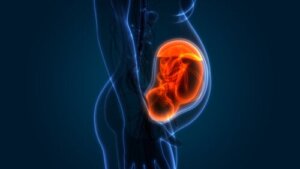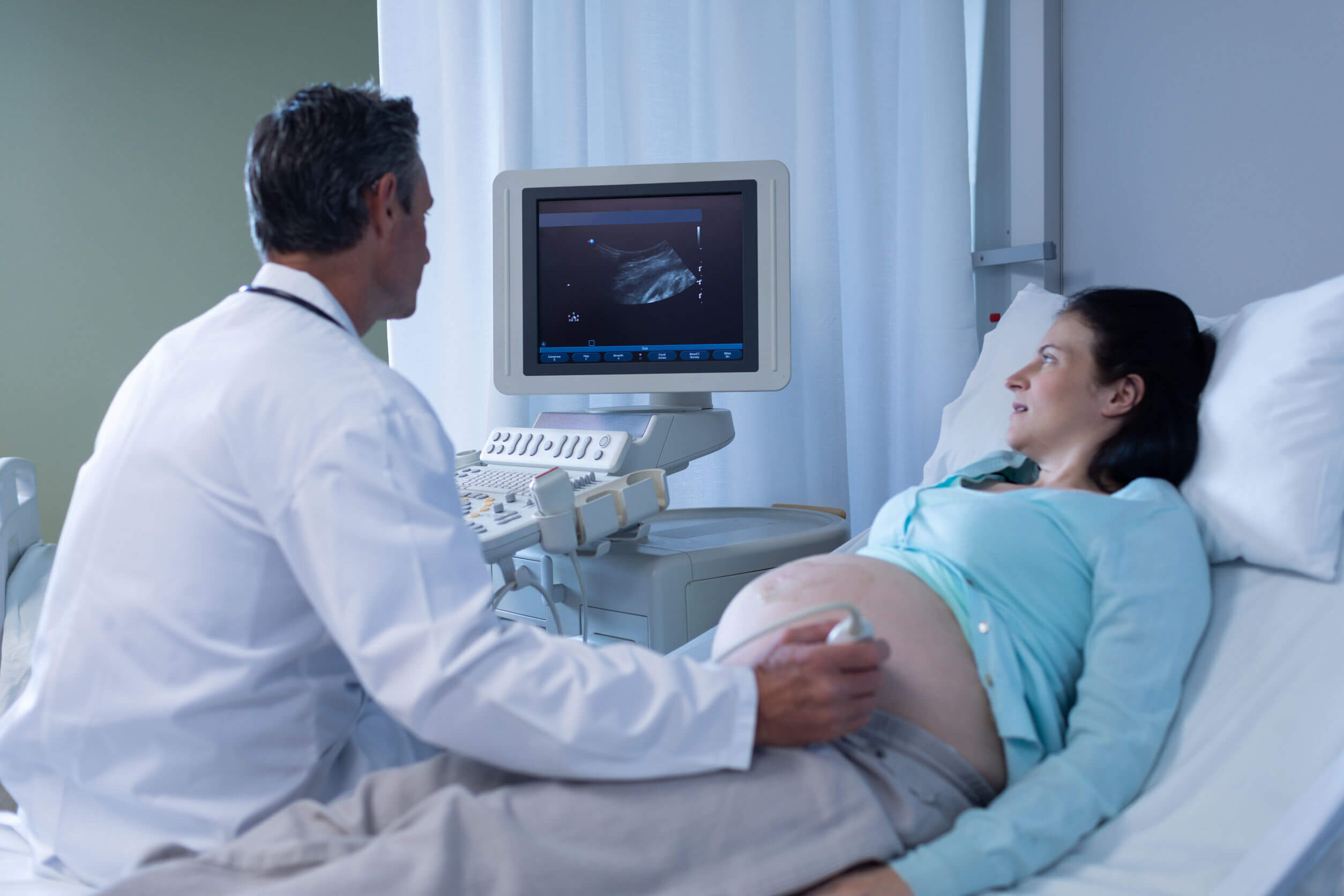The Grades of Placenta Maturity

The grades of placenta maturity are evidenced through pregnancy ultrasound. Throughout this test, the physician evaluates the physiological modifications or the appearance of this transitory organ and, based on the findings, determines its evolutionary stage.
Let us see below what these stages are and what happens in the placental tissue in each one of them.
What is the placenta and what is its function?
The placenta is a transitory intrauterine organ, which is formed together with the embryo and is expelled from the maternal body only a few minutes after the birth of the baby. It has a disc-shaped appearance and reaches about 8.5 inches in diameter and weighs a little over a pound toward the end of gestation.
This precious organ fulfills an important function, which is to keep the baby alive. Not only does it provide the baby with everything it needs for its well-being, but it also helps it to filter and expel the wastes produced by its body.
Through the uterine arteries, the placenta takes oxygen and nutrients from the maternal blood and then transfers them to the baby through the umbilical cord. Conversely, it takes the waste products of fetal metabolism through the umbilical cord and releases them into the maternal circulation, to be finally eliminated by the adult liver.
In addition to the maternal-fetal exchange function, the placenta produces some pregnancy hormones, which are absolutely necessary for everything to run smoothly until birth.

Grades of placenta maturity
As mentioned earlier, one of the characteristics of this organ is its transience. Therefore, it forms and matures along with the baby. Towards the end of pregnancy, it begins to degenerate in a programmed manner to finally be eliminated after delivery, during the delivery stage.
One of the signs of the passage of time that the placenta manifests are calcifications, which can affect fetal nutrition and oxygenation. Thus, both the presence of calcium in its structure and its general appearance allow the specialist to establish the grade of maturity of the organ in question.
There are different placental maturity classifications, but the one most commonly used by gynecologists is the Grannum classification, developed by Grannum and his collaborators in 1979. This classification establishes 4 grades, and we’ll explain them below.
Grade 0
This is the stage that characterizes the first trimester and the beginning of the second trimester, as it’s the youngest stage of the placenta. Ultrasounds show that the basal plate (the side facing the uterus) and the chorionic plate (the side facing the fetus) maintain a homogeneous and uniform aspect, without calcifications.
Grade I
Towards the end of the second trimester or the first weeks of the third trimester, white or echogenic areas are already visible on ultrasound. These correspond to the first superficial calcifications (thin and wavy), which usually mainly affect the chorionic plate.
At this stage, the plates are no longer observed as uniform, as the chorionic plate begins to show signs of advancing time, but the basal plate remains intact.
Grade II
At this stage of placental maturity, the chorionic and basal plates are clearly distinct:
- The basal plate is completely identified, as it gives the impression of being separated from the myometrium (muscular wall of the uterus).
- The chorionic plaque, on the other hand, has a discontinuous, wavy profile with calcifications.
Grade III
This is the maximum grade of placenta maturity, as a result of which it’s referred to as aged or hypermature. It’s normal for this grade to be reached between 39 and 40 weeks, but sometimes it can occur some time earlier.
The following are its most important characteristics:
- Abundant calcium deposits in the basal and chorionic plaque
- Several echogenic areas in the basal plate
- Fusion of the placental septa
- Calcification and degeneration within the placental cotyledons

What does it mean that the placenta is mature or aged?
The process of placental maturity helps the specialist to infer how fetal well-being is. If the placenta matures prematurely, it may indicate a gestational complication, such as preeclampsia.
In this sense, if a placenta reaches grade II or III before 34 weeks of pregnancy, it’s assumed to have matured earlier than expected and is insufficient to meet the baby’s needs. This increases the risk of health complications for the baby, such as the following:
- Nutritional deficit or low birth weight
- Fetal hypoxia
- Uterine growth restriction
- Premature births
Recently, a study was conducted to determine the risk of perinatal complications in pregnant women with a grade 3 placenta before 35 weeks. The researchers concluded that early placental aging was associated with a high frequency of perinatal complications. In fact, almost 30% of the newborns of these mothers had low birth weight and respiratory distress syndrome.
In some cases, and depending on the assessment of the specialists, placental insufficiency secondary to calcifications or hardening of the organ earlier than expected could be a cause for early termination of pregnancy.
For this reason, it’s common for the physician to complement the third-trimester ultrasound with a Doppler of the umbilical arteries and the placenta in order to check the oxygenation of the baby at this stage. If a problem is detected, maternal rest and more frequent monitoring of the pregnancy will be recommended. This would help prevent putting the baby’s life at risk.
Even so, premature aging of the placenta has an impact on fetal growth, hence the importance of strict prenatal control, especially in a high-risk pregnancy.
The grades of placenta maturity are evidenced through pregnancy ultrasound. Throughout this test, the physician evaluates the physiological modifications or the appearance of this transitory organ and, based on the findings, determines its evolutionary stage.
Let us see below what these stages are and what happens in the placental tissue in each one of them.
What is the placenta and what is its function?
The placenta is a transitory intrauterine organ, which is formed together with the embryo and is expelled from the maternal body only a few minutes after the birth of the baby. It has a disc-shaped appearance and reaches about 8.5 inches in diameter and weighs a little over a pound toward the end of gestation.
This precious organ fulfills an important function, which is to keep the baby alive. Not only does it provide the baby with everything it needs for its well-being, but it also helps it to filter and expel the wastes produced by its body.
Through the uterine arteries, the placenta takes oxygen and nutrients from the maternal blood and then transfers them to the baby through the umbilical cord. Conversely, it takes the waste products of fetal metabolism through the umbilical cord and releases them into the maternal circulation, to be finally eliminated by the adult liver.
In addition to the maternal-fetal exchange function, the placenta produces some pregnancy hormones, which are absolutely necessary for everything to run smoothly until birth.

Grades of placenta maturity
As mentioned earlier, one of the characteristics of this organ is its transience. Therefore, it forms and matures along with the baby. Towards the end of pregnancy, it begins to degenerate in a programmed manner to finally be eliminated after delivery, during the delivery stage.
One of the signs of the passage of time that the placenta manifests are calcifications, which can affect fetal nutrition and oxygenation. Thus, both the presence of calcium in its structure and its general appearance allow the specialist to establish the grade of maturity of the organ in question.
There are different placental maturity classifications, but the one most commonly used by gynecologists is the Grannum classification, developed by Grannum and his collaborators in 1979. This classification establishes 4 grades, and we’ll explain them below.
Grade 0
This is the stage that characterizes the first trimester and the beginning of the second trimester, as it’s the youngest stage of the placenta. Ultrasounds show that the basal plate (the side facing the uterus) and the chorionic plate (the side facing the fetus) maintain a homogeneous and uniform aspect, without calcifications.
Grade I
Towards the end of the second trimester or the first weeks of the third trimester, white or echogenic areas are already visible on ultrasound. These correspond to the first superficial calcifications (thin and wavy), which usually mainly affect the chorionic plate.
At this stage, the plates are no longer observed as uniform, as the chorionic plate begins to show signs of advancing time, but the basal plate remains intact.
Grade II
At this stage of placental maturity, the chorionic and basal plates are clearly distinct:
- The basal plate is completely identified, as it gives the impression of being separated from the myometrium (muscular wall of the uterus).
- The chorionic plaque, on the other hand, has a discontinuous, wavy profile with calcifications.
Grade III
This is the maximum grade of placenta maturity, as a result of which it’s referred to as aged or hypermature. It’s normal for this grade to be reached between 39 and 40 weeks, but sometimes it can occur some time earlier.
The following are its most important characteristics:
- Abundant calcium deposits in the basal and chorionic plaque
- Several echogenic areas in the basal plate
- Fusion of the placental septa
- Calcification and degeneration within the placental cotyledons

What does it mean that the placenta is mature or aged?
The process of placental maturity helps the specialist to infer how fetal well-being is. If the placenta matures prematurely, it may indicate a gestational complication, such as preeclampsia.
In this sense, if a placenta reaches grade II or III before 34 weeks of pregnancy, it’s assumed to have matured earlier than expected and is insufficient to meet the baby’s needs. This increases the risk of health complications for the baby, such as the following:
- Nutritional deficit or low birth weight
- Fetal hypoxia
- Uterine growth restriction
- Premature births
Recently, a study was conducted to determine the risk of perinatal complications in pregnant women with a grade 3 placenta before 35 weeks. The researchers concluded that early placental aging was associated with a high frequency of perinatal complications. In fact, almost 30% of the newborns of these mothers had low birth weight and respiratory distress syndrome.
In some cases, and depending on the assessment of the specialists, placental insufficiency secondary to calcifications or hardening of the organ earlier than expected could be a cause for early termination of pregnancy.
For this reason, it’s common for the physician to complement the third-trimester ultrasound with a Doppler of the umbilical arteries and the placenta in order to check the oxygenation of the baby at this stage. If a problem is detected, maternal rest and more frequent monitoring of the pregnancy will be recommended. This would help prevent putting the baby’s life at risk.
Even so, premature aging of the placenta has an impact on fetal growth, hence the importance of strict prenatal control, especially in a high-risk pregnancy.
All cited sources were thoroughly reviewed by our team to ensure their quality, reliability, currency, and validity. The bibliography of this article was considered reliable and of academic or scientific accuracy.
- Barber, M. et al. (2001). Insuficiencia placentaria: concepto y causas. Visión actual. Clínica e Investigación en Ginecología y Obstetricia, 28(3). https://www.elsevier.es/es-revista-clinica-e-investigacion-ginecologia-obstetricia-7-pdf-S0210573X0177075X
- Grannum, P. A., Berkowitz, R. L., Hobbins, J. C. (1979). The ultrasonic changes in the maturing placenta and their relation to fetal pulmonic maturity. Am J Obstet Gynecol, 133(8), 915-22. https://pubmed.ncbi.nlm.nih.gov/434036/
- Manrique, M., Huertas, E. (2021). Envejecimiento placentario precoz y complicaciones perinatales. Revista Peruana de Ginecología y Obstetricia, 67(4). http://www.scielo.org.pe/scielo.php?script=sci_arttext&pid=S2304-51322021000400003
- Sosa, A. (2001). Maduración precoz de la placenta ¿Indicación para interrumpir un embarazo? Revista de Obstetricia y Ginecología de Venezuela, 61(1). http://ve.scielo.org/scielo.php?script=sci_arttext&pid=S0048-77322001000100002
This text is provided for informational purposes only and does not replace consultation with a professional. If in doubt, consult your specialist.








